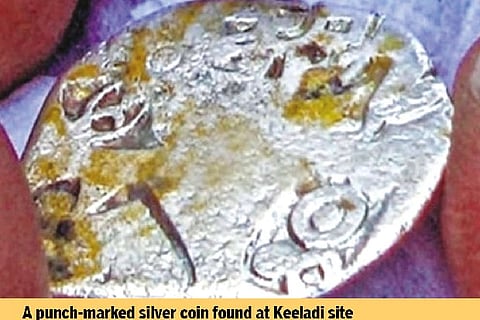

Madurai
Keeladi, with its rich storehouse of antiquities, has hogged the limelight, especially with the recent finding of a punch-marked silver coin dating back to the ancient Maurya dynasty. The silver coin was a hidden treasure with symbols of sun, flower and Nandi. The ongoing phase of excavation, which took off in February and lasts till September, discovered over 1,200 antiquities and artefacts. But the silver punch-marked coin assumes greater significance.
During the last season, excavations were done to a depth of 18 to 22 feet, but now only 16 feet has been completed. A stunning array of precious antiquities remains exhibited for the public at World Tamil Sangam to have a glimpse, sources said.
Much to the likes of people, an on-site museum is getting ready at Keeladi on two acres at a cost of Rs 12.21 crore. The PWD authorities have insisted on completing the construction this year. Once the museum comes up, all antiquities would be brought back from the World Tamil Sangam and displayed at the museum, sources said.
On the silver punch-marked coin, C Santhalingam, a Madurai-based archaeologist (retired) and founder of Pandya Nadu Centre for Historical Research, said the antique coin dates back to the 3rd century BC. These coins were depicted with celestial symbols even before the script form came into existence. But after the ancient form of script existed, names of kings and rulers replaced such symbols on antique silver coins.
Alagankulam, once a port city in Ramanathapuram, also explores the Vaigai river civilization. Earlier, archaeological excavations there discovered oval-shaped silver punch-marked coins. “The discovery of such precious silver coins is more evidence of Indo-Roman trade relations,” Dr Santhalingam said, referring to the finds of silver coins with the name of the first Rome’s first emperor Augustus Caesar at Poonjar, which was once a part of Travancore princely state.
Tracing the epic trade journey of the ancient Romans from Kerala through the Pandya Nadu, the archaeologist told DT Next that a farmer at Uthamapuram near Theni, made an accidental finding of nine silver coins bearing the name of the Roman emperor and silver from a mud pot, and a bunch of antique silver coins at Bodi Mettu, during the 90s.
“Roman trade relations relied on usage coins next to the barter system in India, especially the Pandya Nadu from where spices such as Bodi fame cardamom and clove were purchased. In the days of yore, maritime trade existed with the aid of seaports in Thoothukudi, known for its pearl, Alangulam and Thondi in Ramnad along the East coast,” Dr Santhalingam recalled.
Visit news.dtnext.in to explore our interactive epaper!
Download the DT Next app for more exciting features!
Click here for iOS
Click here for Android